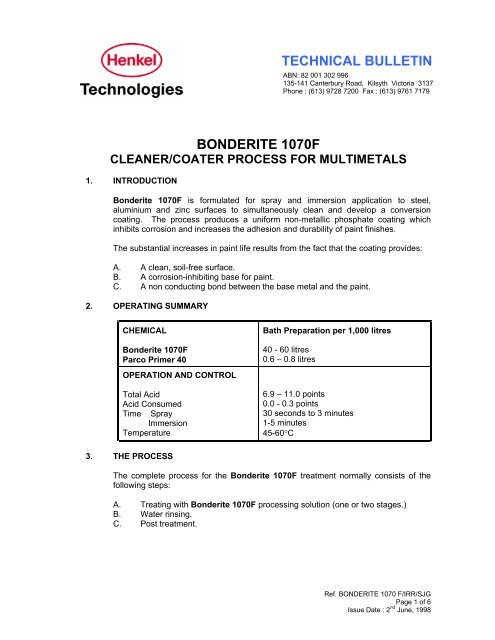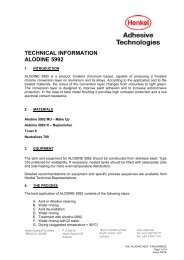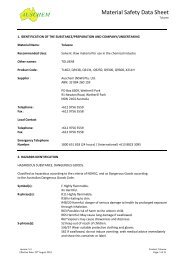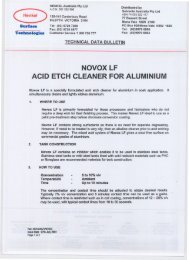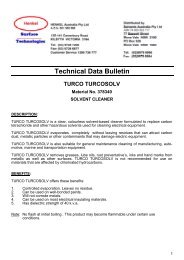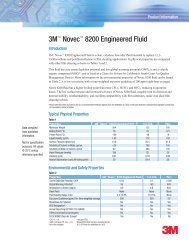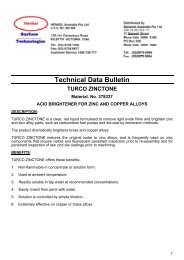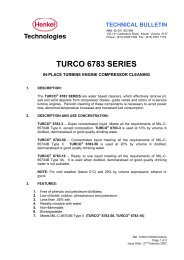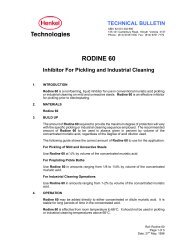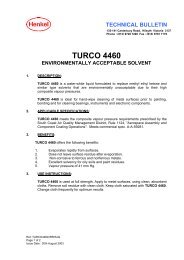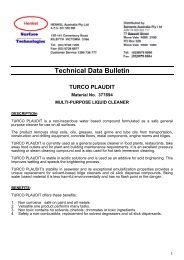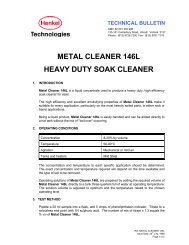You also want an ePaper? Increase the reach of your titles
YUMPU automatically turns print PDFs into web optimized ePapers that Google loves.
TECHNICAL BULLETINABN: 82 001 302 996135-141 Canterbury Road, Kilsyth Victoria 3137Phone : (613) 9728 7200 Fax : (613) 9761 7179BONDERITE 1070FCLEANER/COATER PROCESS FOR MULTIMETALS1. INTRODUCTIONBonderite 1070F is formulated for spray and immersion application to steel,aluminium and zinc surfaces to simultaneously clean and develop a conversioncoating. The process produces a uniform non-metallic phosphate coating whichinhibits corrosion and increases the adhesion and durability of paint finishes.The substantial increases in paint life results from the fact that the coating provides:A. A clean, soil-free surface.B. A corrosion-inhibiting base for paint.C. A non conducting bond between the base metal and the paint.2. OPERATING SUMMARYCHEMICALBonderite 1070FParco Primer 40OPERATION AND CONTROLTotal AcidAcid ConsumedTime SprayImmersionTemperatureBath Preparation per 1,000 litres40 - 60 litres0.6 – 0.8 litres6.9 – 11.0 points0.0 - 0.3 points30 seconds to 3 minutes1-5 minutes45-60°C3. THE PROCESSThe complete process for the Bonderite 1070F treatment normally consists of thefollowing steps:A. Treating with Bonderite 1070F processing solution (one or two stages.)B. Water rinsing.C. Post treatment.Ref. BONDERITE 1070 F/IRR/SJGPage 1 of 6Issue Date : 2 nd June, 1998
Bonderite 1070F Page 23. THE PROCESS (continued)D. Deionised water rinse (optional).E. Drying4. MATERIALSBonderite 1070FParco Primer 40Parcolene 6Parcolene (post treatment)Testing Reagents and Apparatus5. EQUIPMENTProcess tanks and housings may be fabricated from mild steel plate, however,equipment life will be greatly extended by using a 300 series alloy stainless steel,such as 304L or 316L. The 316L being preferred for maximum tank life. In all cases,approved welding techniques must be used.Process piping and pumps should be constructed of 316 or 304 stainless steel alloys.Various formulations of plastic pipe may be used with recommended supportspacing. Schedule-80 generally recommended. PVC Type I is limited to maximumprocess temperatures of 60°C. CPVC and PP may be used up to a maximumprocess temperature of 90°C. PVDF may be used for all expected operatingtemperatures and may reduce the rate of scale buildup in process piping.Heat exchanger plates should be polished 316 stainless steel. If gas fired burnertubes are used, they should be made of Schedule-80 mild steel pipe or equivalent.All process circulation pump seals, valve seats, door seals, etc., which come intocontact with the process solution and occasional acid equipment cleaners, should beBuna-N, Viton or Teflon. Note that while Hypalon is compatible with the processsolution, it is not compatible with acid equipment cleaners which may be used.Chemical feed pump parts and other elastomers which may come into contact withthe concentrated replenishing chemical should be Buna-N, Hypalon, Viton or Teflon.Our sales representative should be consulted for information on automatic processcontrol equipment for this process and any additional questions. In addition, the"Parker Amchem Equipment Design Manual" may be consulted.6. TREATING WITH BONDERITE 1070F PROCESS SOLUTIONBuildupFill the tank about three-fourths full with cold water. Add 40 to 60 litres of Bonderite1070F for each 1,000 litres of working solution volume. Add sufficient water to bringthe solution up to the working level and then heat to the operating temperature.Ref. BONDERITE 1070 F/IRR/SJGPage 2 of 6Issue Date : 2 nd June, 1998
Bonderite 1070F Page 36. TREATING WITH BONDERITE 1070F PROCESS SOLUTION (continued)Buildup (continued)OperationTime:Temperature:Application:Spray 30 seconds to 3 minutesImmersion 1 - 5 minutes45 - 70°CPower spray or immersionAfter the best values for time and temperature have been established, they should bemaintained closely. Temperature should be held within + 3°C.7. TESTING AND CONTROLNever pipette by mouth. Use a pipette filler.Total AcidPipette a 10 ml sample into a 150 ml beaker. Add 5 drops of Indicator 3, then titratewith Titrating Solution 11 to the development of a permanent pink colour. The ml ofTitrating Solution 11 required, indicates the Total Acid value in points.Total Acid range : 6.9 – 11.0 pointsTo increase value 1.0 points : 6.0 litres of Bonderite 1070F per 1,000 litres ofsolution volume.Acid Consumed- After adjusting the Total Acid points to the recommended range, pipette a 10ml sample into a 150 ml beaker. Add 4 drops of Indicator 2.- If the colour developed is green, the Acid Consumed = 0.0. This is the idealcondition of the bath.- If the colour developed is blue, the bath is on the Acid Consumed side. Titratewith Titrating Solution 20 to a green end point. The ml of Titrating Solution 20used is the Acid Consumed value in points.- If the colour developed is yellow, the bath is on the Free Acid side. Titratewith Titrating Solution 11 to a green end point. The ml of Titrating Solution 11used is the Free Acid value in points.Optimum Acid Consumed range:To increase value 0.1 point:To decrease value 0.1 point:0.0-0.3 points900 mls of Parco Primer 40 per 1,000 litres ofsolution volume.320 mls of Parcolene 6 per 1,000 litres ofsolution volume.Ref. BONDERITE 1070 F/IRR/SJGPage 3 of 6Issue Date : 2 nd June, 1998
Bonderite 1070F Page 48. AFTER TREATMENTWater RinsingAfter phosphating, the work is thoroughly rinsed with water at ambient temperaturesfor 20-40 seconds. The rinse should be continuously overflowed, and the flow shouldbe regulated with the rate of production so that the main body of the rinse neverbecomes excessively contaminated.Post TreatmentThe coated metal, wet from the water rinse, is treated with a dilute Parcolene (posttreatment) solution. This treatment materially increases the corrosion resistance ofthe coating and is an essential part of the process. A number of Parcolene productsare available and our representative will recommend the proper one for eachinstallation.Deionised Water RinseA water rinse may be required following the post treatment. Deionised water ispreferred but relatively pure tap water may be used. The paint used and the qualityrequired for the finished part will determine if rinsing is necessary and if deionisedwater must be used.9. STORAGE REQUIREMENTSNo special storage is needed for the products used in this process. Bonderite 1070Ffreezes at -10°C. Should it freeze, simply thaw it to room temperature and stir prior touse. Do not store with chlorine containing materials.10. GENERAL MAINTENANCEIn the operation of the process, a small quantity of sludge is formed as a by-productof the coating reaction. This residue settles to the bottom of the tank and should beremoved before its presence causes dusty coating, or interferes with the operation ofthe spraying system. A satisfactory method of removal is to transfer the solution to arinse tank, leaving as much sludge as possible in the bottom of the processing tank.The sludge may then be removed by any convenient means.When the solution has been heated for some time, scale will form on the heating unitand must be removed at intervals so that adequate heat transfer will occur and theproper processing temperature will be maintained. To remove the scale, dry the heattransfer surface, either by removing it from the solution or by pumping the solutionfrom the tank. The scale may then be removed by a suitable chemical or mechanicalmethod.Ref. BONDERITE 1070 F/IRR/SJGPage 4 of 6Issue Date : 2 nd June, 1998
Bonderite 1070F Page 511. WASTE DISPOSAL INFORMATIONDisposal information for the chemical, in the form as supplied, is given on the MaterialSafety <strong>Data</strong> <strong>Sheet</strong>.The processing bath is slightly acidic and contains phosphate. Neutralisation and/orwaste treatment of rinse water or processing solution may be required prior todischarge.The processing bath and sludge which accumulates in the bath, can containingredients other than those present in the chemical as supplied and analysis of thesolution and/or sludge may be required prior to disposal.12. PRECAUTIONARY INFORMATIONWhen handling the chemical products used in this process, the first aid and handlingrecommendations on the Material Safety <strong>Data</strong> <strong>Sheet</strong> for each product should be read,understood and followed.The processing bath is slightly acidic and may cause irritation of skin and eyes. Donot get in eyes, on skin or on clothing. In case of contact, follow therecommendations on the Material Safety <strong>Data</strong> <strong>Sheet</strong> for Bonderite 1070F.DISCLAIMERAny information given is, to the best of our knowledge, the best currently available, with respect to our products and their use,but it is subject to revision as additional knowledge and experience is gained. Such information is offered as a guideline forexperimentation only and is not to be construed as a representation that the material is suitable for any particular purpose oruse. Customers are encouraged to make their own enquiries as to the material's characteristics and, where appropriate, toconduct their own tests in the specific context of the material's intended use. This information is not a license to operate undernor is it intended to suggest infringement of any patent. We guarantee a uniform quality standard for this product. The onlyconditions and warranties accepted by Henkel in relation to this product or process are those implied by either Commonwealthor State statutes.Ref. BONDERITE 1070 F/IRR/SJGPage 5 of 6Issue Date : 2 nd June, 1998
Bonderite 1070F Page 6TESTING REAGENT & APPARATUS(Order only those items which are not already on hand)QUANTITYITEM2* Flask, glass, 250 ml1 Beaker, graduated, plastic, 250 ml2 Burette assembly, 25 ml automatic, glass1 litre Indicator 3 (Phenolphthalein)1 litre Indicator 2 (Bromocresol Green)2 Indicator dropping bottle, 50 ml2* Pipette 10 ml volumetric, glass1 Pipette filler1 Measuring cylinder, graduated, plastic 100 ml1 Thermometer, floating5 litre Titrating Solution 11 (0.1N NaOH)5 litre Titrating Solution 20 (0.1N H 2 SO 4 )* Includes one more than actually required to allow for possible breakage.Ref. BONDERITE 1070 F/IRR/SJGPage 6 of 6Issue Date : 2 nd June, 1998


